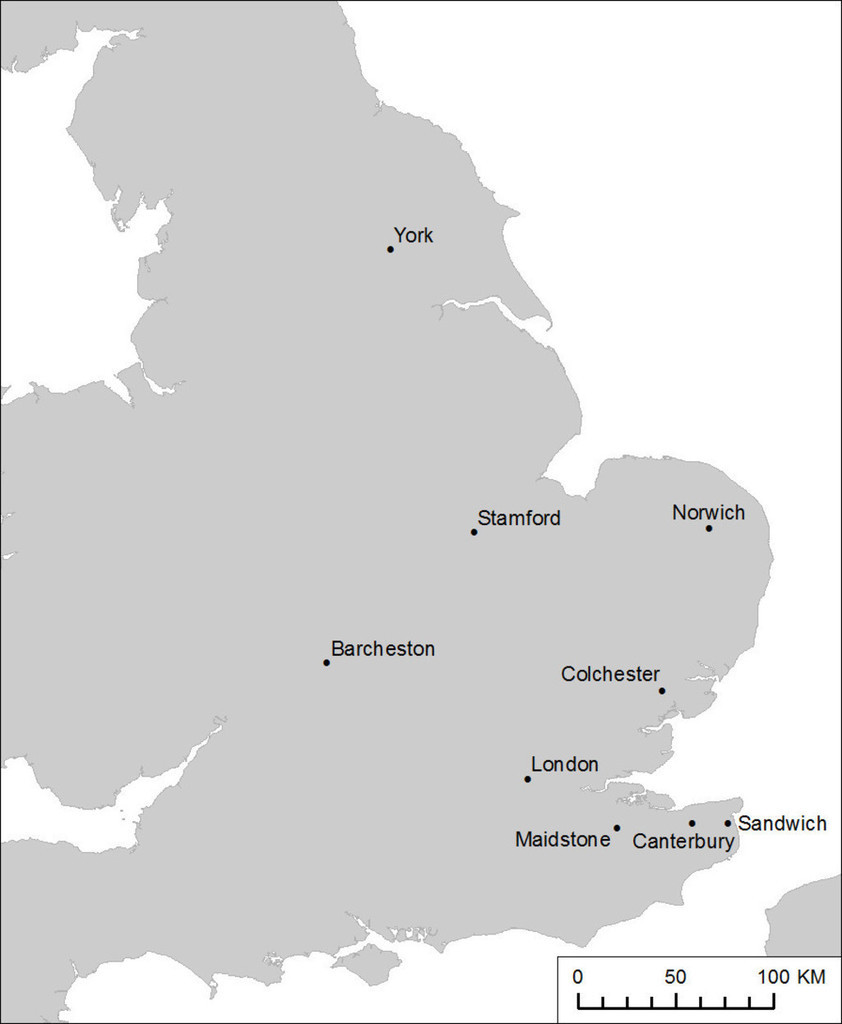Many tapestries, particularly small ones, were woven by men about whom we know nothing, not even their names. However, tapestries over a certain size were often ‘signed’ with the mark of the master weaver. This was made up of his initials arranged as a pattern. It had to be registered with his local guild, which also judged the quality of the finished tapestry. If satisfactory, the guild allowed another mark, that of the city where the weaving took place, to be woven into the lower border. It was not until the seventeenth century that this system developed in England.
No marks are found in the Fitzwilliam tapestries. They were not thought necessary for small items. We can only guess therefore where the Fitzwilliam tapestries were made by comparing their style and appearance with other small items. People wanted luxury objects whatever country they lived in, but weavers in different places did not always represent scenes or individual figures in exactly the same way, even if they were following the same or a very similar print or tapestry. And of course not every small workshop could afford to pay a skilled, or even a competent, draughtsman to make the cartoon. Some master weavers may have drawn their own patterns.
The heartlands of the tapestry industry in the sixteenth century was in what today is called Belgium, in the towns of Brussels, Oudenarde, Enghien and later in Antwerp. The inhabitants tended towards the new Protestant religion but because the area was ruled by the Catholic king of Spain there was constant warfare. This, together with the fact that there were too many weavers for all of them to find employment against a disrupted commercial background, meant that many emigrated – north to Holland and west and north into the German principalities and beyond.
Others came to England, especially after 1560 following the accession of the Protestant Queen, Elizabeth I. The majority settled in London; others were invited by the town councils of Sandwich, Canterbury, Maidstone, Colchester and Norwich in the hope that new industries would revive the flagging local economies.

The settlement of émigrés was encouraged by the English government, aware that England lacked skilled craftsmen in the luxury trades, and the country was importing goods that could be produced at home. Some noblemen tried to set up workshops for foreign workers, usually with the obligation that they should pass on their skills to the native-born. William Cecil, Queen Elizabeth’s Secretary, tried to establish a settlement of weavers at Stamford, Lincolnshire around 1567, not, apparently with any great success.
Another man who planned a similar enterprise was a Worcestershire gentleman, William Sheldon. His will set out a scheme that would provide capital sums as loans for trained weavers, English or foreign-born, to enable them to set up independently. He also allowed a man we know as Richard Hyckes to occupy the family’s manor house at Barcheston, Warwickshire, rent-free as long as he organised the production of tapestry and woven cloth. How successful his plans were is unknown. Nothing is documented; there is no contract for any of the weavings now called Sheldon, nor do the workshop’s accounts survive.
It was not until 1919 that a local antiquary claimed five tapestries, previously ignored, at nearby Chastleton House, as Barcheston work. Thereafter almost any tapestry without known origin or any tapestry with an English coat of arms became known as Sheldon work, from Barcheston. But there was no solid explanation why this should be so. Four years later another scholar deduced more definite stylistic characteristics from the same five large tapestries to serve as criteria for a Barcheston provenance. However, he did not raise the question of whether or not the pieces might really have originated at Barcheston. Those characteristics included a floral ground or small figures within an arch; their vertical borders showed grotesque figures (usually female) between floral arrangements, their horizontal borders contained hunting scenes. Recent research suggests that there were never convincing reasons to connect the Chastleton tapestries found in 1919 with Barcheston.
It now seems more probable that they were woven elsewhere, possibly Germany. They therefore have no relevance to anything that Sheldon’s enterprise might have produced. Although the Fitzwilliam tapestries have been thought to be examples from Barcheston, there is no factual justification for this opinion. All the researchers of the 1920s – until recently the only studies of ‘Sheldon’ products – ignored the presence of émigré weavers in London.
But it is the presence of these men that means Barcheston was not the only place in England where tapestry was woven, as was previously thought. The probability that the Fitzwilliam tapestries were woven in London where the émigré weavers established their workshops, and where there was a market, is very strong.




